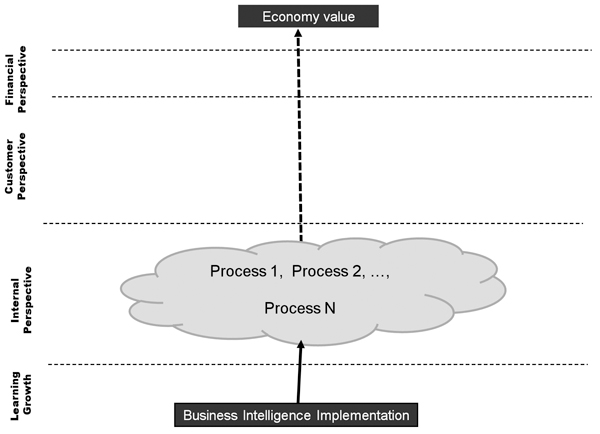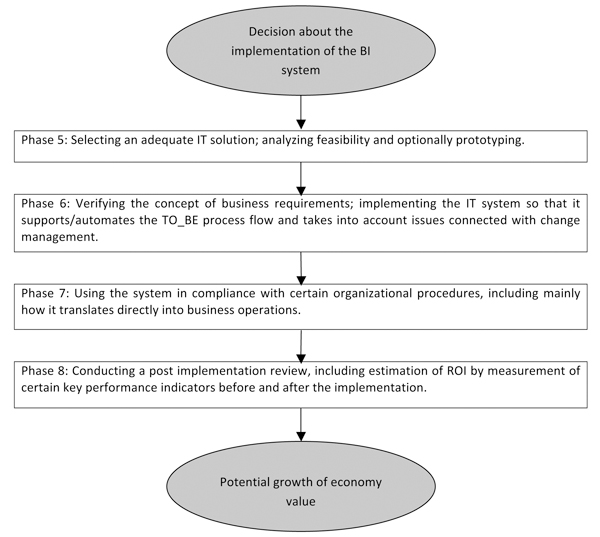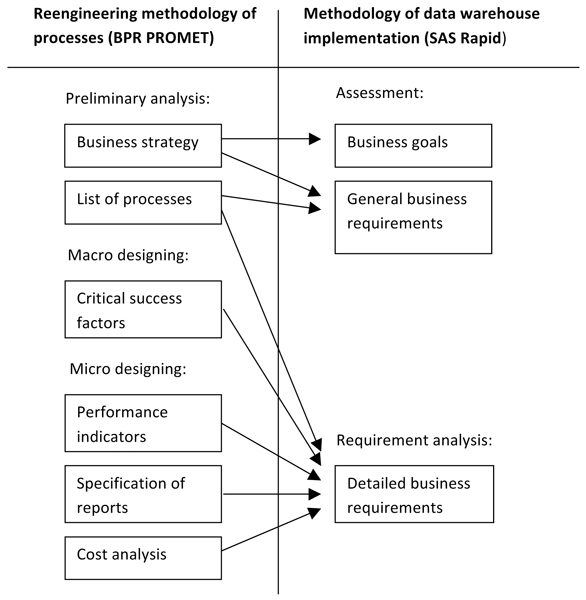6.2. Implementation Methodology
As mentioned before, even the most technologically sophisticated BI alone will not enhance the value of the company alone. It is crucial to connect it with the internal business processes of the company (see Figure 6.3) and take into account the organizational context and the human factor.10 The implementation methodology of a BI system should then meet the following conditions:
- In the context of indirect and potential enhancement of value, it should employ business process reengineering11 and should have a positive influence on the value of the company.12
- As for the human capital and organizational context, it should relate to change management.

Figure 6.3. Indirect enhancement of value by implementing BI.
Source: author.

Figure 6.4. Holistic approach for the methodology of BI implementation.
Source: author.
Meeting these conditions (see Figure 6.4) is a prerequisite for the successful implementation of a BI project. If you want to show the relationship to the economic value of the company, it is vital to adapt the whole to the strategy of the company and draw up clear-cut guidelines on the estimation of return on investment (ROI).13 It should consist of two stages:
- Stage 1: Analysis (see Figure 6.5)
- Phase 1: Reference to the strategy
- Phases 2–3: Business processes reengineering
- Phase 4: Recommendations
- Stage 2: Implementation (see Figure 6.6)
- Phases 5–6: Implementation of recommendations
- Phases 7–8: Use and analysis of ROI

Figure 6.5. Stage 1: Analysis—referring to strategy and process reengineering.
Source: author.

Figure 6.6. Stage 2: Implementation and use of the system.
Source: author.
The link between stages 1 and 2 (from phases 4 to 6) is the management board strategic decision to implement the BI solutions devised by reengineering of the business processes. In most cases, it will be the implementation based on the data warehouse approach, as described in chapter 2. A review of the most common methods for implementing data warehouses can be found in O’Donnell’s14 and Adelman and Moss’s15 studies. The classic example is the SAS Rapid Methodology16 (see Figure 6.7). Figure 6.8 shows how the results of the reengineering of business processes are transferred from the PROMET BPR methodology (from stage 1; see Figure 6.5) to the SAS Rapid Methodology (to stage 2; see Figure 6.6). If the system is designed to provide managerial information through online analytical processing (OLAP) tools, the integration is based on the following chain of connections:
strategy → processes → critical success factors (CSFs) → key performance indicators17 → implementation of the managerial information system

Figure 6.7. Stages of data warehouse designing.
Source: Based on SAS (2000).

Figure 6.8. Linkage between the reengineering methodology of processes and the implementation methodology (PROMET BPR versus SAS Rapid Metholdogy).
Source: author.
If the implementation of the strategic initiative requires the use of advanced data-mining techniques, then for phase 6 (see Figure 6.6) you will have to use of the specialized methodology of data-mining methods (i.e., the cross-industry standard process for data mining, or CRISP-DM).18 The transformation process from data in a data warehouse to potentially useful knowledge produced by means of CRISP-DM is shown in Figure 6.9 (see also chapter 4). It should be stressed that the aforementioned methodology (from reference to the strategy of the company to the evaluation of business profits from the BI implementation) is the most appropriate if the company has a clear-cut strategy. In such a strategy, business processes are identified first, and then the most suitable recommendations for BI application are matched to them. However, in practice, companies usually do not have a clear strategy for IT development, and investment decisions are made ad hoc, based on the principle “let’s implement system x in department y.”19

